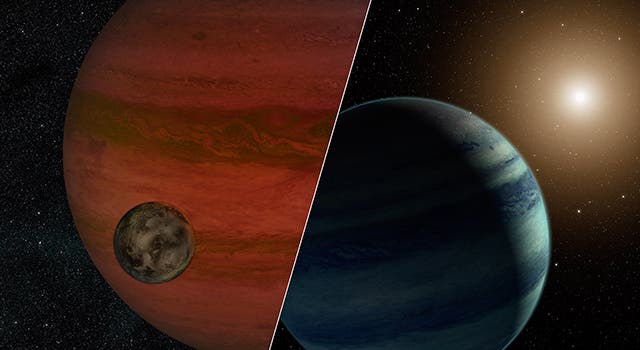
Until just a few decades ago, there wasn’t any proof that there were any planets beyond those in our solar system, although of course everybody expected them to exist somewhere. After the Kepler Space Telescope was deployed, astronomers found not one, but a couple hundred exoplanets (planets orbiting other stars). In fact, our galaxy is supposed to harbor some 50 billion Earth-like planets. Now, after observational techniques have become more refined, a joint Japan-New Zealand-American team spotted the first signs of an “exomoon,” and though they say it’s impossible to confirm its presence, the finding is a tantalizing first step toward locating others.
First moon outside our solar system?
The team used ground-based telescopes in New Zealand and Tasmania and applied a technique called gravitational microlensing – a sort of natural occurring optical enhancer. Imagine the observer as being the telescopes and in between your target object (a star), lies a massive object (another star) in the foreground. This cushion star acts like a magnifying glass to focus and brighten the light of the more distant one using its gravity. Astronomers have been using this sort of the technique for years with marvelous results – they’ve even been able to peer through billions of light years , otherwise impossible using direct observations.
There’s more to it, however. If the foreground star has a planet orbiting around it, then the said planet has a gravitational effect on the incoming light as well, further dimming or brightening light, by case. By making precise measurements and comparing brightness events, astronomers can tell how massive is a star relative to its planetary companion.
What if the foreground object is a massive planet itself, and not a star? It can happen, we’ve seen that rogue planets – drifting planets through the galaxy – are a reality, so there’s a chance these could affect observations. In our particular case, the joint Japan-New Zealand-American Microlensing Observations in Astrophysics (MOA) and the Probing Lensing Anomalies NETwork (PLANET) programs found the ratio of the larger body to its smaller companion is 2,000 to 1.
A moon or a planet?
So, we’ve got two cases on our hands: either the object in question is a faint-star circled by a planet about 18 times larger than Earth, or the object is in fact a planet about the size of Jupiter, circled by a moon smaller than Earth. No matter what the reality may be, right now there is no way astronomers can tell which of the two is true.
“One possibility is for the lensing system to be a planet and its moon, which if true, would be a spectacular discovery of a totally new type of system,” said Wes Traub, the chief scientist for NASA’s Exoplanet Exploration Program office at NASA’s Jet Propulsion Laboratory, Pasadena, Calif., who was not involved in the study. “The researchers’ models point to the moon solution, but if you simply look at what scenario is more likely in nature, the star solution wins.”
The Kepler Space Telescope has studied thousands of stars, but it was never equipped to find one or multiple moons orbiting a planet. Discovering an exomoon would be nothing short of amazing, indeed. In the future, however, astronomers might be able to avoid this sort of stalemates by using the parallax-technique. Basically, you need two observing bodies in space, far enough from each other – like Spitzer and Kepler. The basic principle of parallax can be explained by holding your finger out, closing one eye after the other, and watching your finger jump back and forth. A distant star, when viewed from two telescopes spaced really far apart, will also appear to move. When combined with a lensing event, the parallax effect alters how a telescope will view the resulting magnification of starlight.
Findings were reported in the Astrophysical Journal.






